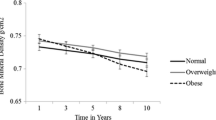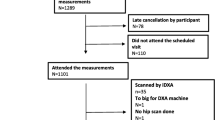Abstract
Summary
We examined the effect of weight and weight change on the long-term precision of spine and hip bone mineral density (BMD) in a group of 64 postmenopausal women studied over a 10-year period. Long-term precision errors were 50% larger than short-term errors. Over the range 50–90-kg weight was associated with a statistically significantly larger precision error when precision was expressed in BMD units, but not when expressed as the coefficient of variation (CV). Weight changes up to 5 kg had little effect on precision.
Introduction
Reliable knowledge of the precision of bone mineral density (BMD) measurements is important for the interpretation of follow-up dual-energy X-ray absorptiometry (DXA) scans. In this study, we examined the effect of body weight and change in weight on the long-term precision of spine and hip BMD.
Methods
The study population was a group of 64 postmenopausal women enrolled in a 16-year trial of tibolone. We analyzed the spine, femoral neck, and total hip BMD data acquired over a 10-year period on a Hologic QDR4500A densitometer using linear regression to examine the trend of BMD with time for each subject. Precision was expressed in BMD units (g cm−2) (standard error of the estimate, SEE) and also as the coefficient of variation (CV).
Results
The long-term precision errors were in BMD (CV) units: 0.018 g cm−2 (1.9%) for spine, 0.017 g cm−2 (2.3%) for femoral neck, and 0.016 g cm−2 (1.7%) for total hip BMD. An inverse relationship between CV and BMD was found for the spine (P = 0.003) and total hip (P = 0.043) sites, but none between SEE and BMD. For spine BMD, there were statistically significant correlations between SEE and weight (P = 0.025) and body thickness (P = 0.027). For femoral neck BMD, there were correlations between SEE and weight (P = 0.030), body mass index (BMI) (P = 0.023) and thickness (P = 0.021), but no correlations for total hip BMD or when precision was expressed as the CV. When study subjects were grouped in quartiles according to weight, the spine BMD SEE increased from 0.014 g cm−2 for women in the lowest quartile (46–62 kg) to 0.018 g cm−2 for women in the highest quartile (80–105 kg) (P = 0.008). There was a trend for SEE to be greater in individuals with larger weight changes, although these tended to be the heavier subjects.
Conclusions
From the study, we were able to come up with the following conclusions: (1) long-term precision errors were 50% larger than short-term errors, (2) over the range 50 to 90 kg (BMI: 20–35 kg m−2), body weight had a small but statistically significant effect on precision expressed in BMD units, but not when expressed as the CV, and (3) weight changes up to 5 kg had little effect on precision. More studies of individuals >100 kg are required to fully investigate the dependence of DXA scan precision on weight.





Similar content being viewed by others
References
National Osteoporosis Foundation (2010) Clinician’s Guide to prevention and treatment of osteoporosis. National Osteoporosis Foundation, Washington DC, USA. Available at: http://www.nof.org/professionals/Clinicians_Guide.htm. Accessed 23 Feb 2010
Compston J, Cooper A, Cooper C, Francis R, Kanis JA, Marsh D, McCloskey EV, Reid DM, Selby P, Wilkins M; National Osteoporosis Guideline Group (NOGG) (2009) Guidelines for the diagnosis and management of osteoporosis in postmenopausal women and men from the age of 50 years in the UK. Maturitas 62:105–108
International Society for Clinical Densitometry (ISCD). Official positions 2007. Available at: http://www.iscd.org/Visitors/positions/OP-Index.cfm. Accessed 23 Feb 2010
Bell KJ, Hayen A, Macaskill P, Irwig L, Craig JC, Ensrud K, Bauer DC (2009) Value of routine monitoring of bone mineral density after starting bisphosphonate treatment: secondary analysis of trial data. BMJ 338:b2266
Watts NB, Lewiecki EM, Bonnick SL, Laster AJ, Binkley N, Blank RD, Geusens PP, Miller PD, Petak SM, Recker RR, Saag KG, Schousboe J, Siris ES, Bilezikian JP (2009) Clinical value of monitoring BMD in patients treated with bisphosphonates for osteoporosis. J Bone Miner Res 24:1643–1646
Glüer CC (1999) Monitoring skeletal changes by radiological techniques. J Bone Miner Res 14:1952–1962
Bonnick SL, Johnston CC Jr, Kleerekoper M, Lindsay R, Miller P, Sherwood L, Siris E (2001) Importance of precision in bone density measurements. J Clin Densitom 4:105–110
Gluer CC, Blake G, Lu Y, Blunt BA, Jergas M, Genant HK (1995) Accurate assessment of precision errors: how to measure the reproducibility of bone densitometry techniques. Osteoporos Int 5:262–270
Leslie WD (2006) The importance of spectrum bias on bone density monitoring in clinical practice. Bone 39:361–368
Shepherd JA, Morgan SL, Lu Y (2008) Comparing BMD results between two similar DXA systems using the generalized least significant change. J Clin Densitom 11:237–242
Leslie WD (2008) Factors affecting short-term bone density precision assessment and the effect on patient monitoring. J Bone Miner Res 23:199–204
Sadatsafavi M, Moayyeri A, Wang L, Leslie WD (2008) Heteroscedastic regression analysis of factors affecting BMD monitoring. J Bone Miner Res 23:1842–1849
Welsman J, Knapp K, MacLeod K, Blake G (2009) Obesity increases precision errors in dual energy x-ray absorptiometry measurements. Osteoporos Int 20(Suppl 4):S267–S268
Blake GM, Fogelman I (2008) How important are BMD accuracy errors for the clinical interpretation of DXA scans? J Bone Miner Res 23:457–462
Binkley N, Krueger D, Vallarta-Ast N (2003) An overlying fat panniculus affects femur bone mass measurement. J Clin Densitom 6:199–204
Rymer J, Chapman MG, Fogelman I (1994) Effect of tibolone on postmenopausal bone loss. Osteoporos Int 4:314–319
Rymer J, Robinson J, Fogelman I (2001) Effects of 8 years of treatment with tibolone 2.5 mg daily on postmenopausal bone loss. Osteoporos Int 12:478–483
Rymer J, Robinson J, Fogelman I (2002) Ten years of treatment with tibolone 2.5 mg daily: effects on bone loss in postmenopausal women. Climacteric 5:390–398
Cummings SR, Ettinger B, Delmas PD, Kenemans P, Stathopoulos V, Verweij P, Mol-Arts M, Kloosterboer L, Mosca L, Christiansen C, Bilezikian J, Kerzberg EM, Johnson S, Zanchetta J, Grobbee DE, Seifert W, Eastell R, Trial Investigators LIFT (2008) The effects of tibolone in older postmenopausal women. N Engl J Med 359:697–708
Patel R, Blake GM, Rymer J, Fogelman I (2000) Long-term precision of DXA scanning assessed over seven years in forty postmenopausal women. Osteoporos Int 11:68–75
Blake GM, Parker JC, Buxton FMA, Fogelman I (1993) Dual x-ray absorptiometry: a comparison between fan beam and pencil beam scans. Brit J Radiol 66:902–906
Blake GM, Fogelman I (1995) Replacing dual x-ray absorptiometry scanners: cross-calibration of a new multidetector array system. J Bone Miner Res 10(Suppl 1):S267
Blake GM (1996) Replacing DXA scanners: cross-calibration with phantoms may be misleading. Calcif Tissue Int 59:1–5
QDR for Windows XP Reference manual (2004) Hologic Inc, Bedford, MA, pp 9.21–9.23.
Altman DG (1991) Practical statistics for medical research. Chapman & Hall, London
Shepherd JA, Fan B, Lu Y, Lewiecki EM, Miller P, Genant HK (2006) Comparison of BMD precision for Prodigy and Delphi spine and femur scans. Osteoporos Int 17:1303–1308
Holland WW, Whitehead TP (1974) Value of new laboratory tests in diagnosis and treatment. Lancet 304:391–394
Hangartner TN (2007) A study of the long-term precision of dual-energy X-ray absorptiometry bone densitometers and implications for the validity of the least-significant change calculation. Osteoporos Int 18:513–523
Noon E, Singh S, Cuzick J, Spector TD, Williams FM, Frost ML, Howell A, Harvie M, Eastell R, Coleman RE, Fogelman I, Blake GM (2010) Significant differences in UK and US female bone density reference ranges. Osteoporos Int. 2010 Jan 9. [Epub ahead of print].
Conflicts of interest
None.
Author information
Authors and Affiliations
Corresponding author
Rights and permissions
About this article
Cite this article
Rajamanohara, R., Robinson, J., Rymer, J. et al. The effect of weight and weight change on the long-term precision of spine and hip DXA measurements. Osteoporos Int 22, 1503–1512 (2011). https://doi.org/10.1007/s00198-010-1339-6
Received:
Accepted:
Published:
Issue Date:
DOI: https://doi.org/10.1007/s00198-010-1339-6




